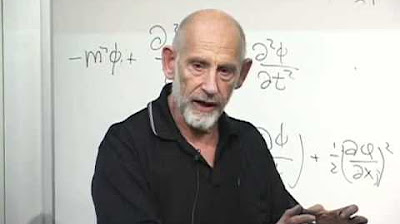Lecture 5 | String Theory and M-Theory
TLDRThe video script is an in-depth exploration of string theory, focusing on the concept of a hron—a fundamental string that can be excited by rotation or vibration. The lecturer delves into the energy associated with these excitations and introduces the idea that the energy of a string is proportional to the square of its mass, a relationship determined by the string's tension. The discussion then transitions into the units of string theory, emphasizing the importance of the Planck constant and the speed of light. The Planck length and time are calculated, providing a sense of scale for the string's oscillations. The script also touches on the implications of string theory for particle physics and the potential for unifying forces. It concludes with a brief mention of extra dimensions and the mathematical foundation of string theory, specifically conformal invariance, which will be covered in subsequent lectures.
Takeaways
- 📐 **String Theory Basics**: A hron (a theoretical string) can be excited by rotation or vibration, similar to a spring, and these excitations correspond to certain energy levels.
- ⚖️ **String Energy and Mass**: The energy of a string is identified with the square of its mass, which is related to the string's tension and its length.
- 🧵 **String Tension**: The tension in the string, which is energy per unit length, sets the fundamental scale for the string and determines the energy jump between excited states.
- 🔢 **Units in String Theory**: String theory operates with units where the speed of light and Planck's constant are equal to one, simplifying many equations.
- 🌌 **Planck Units**: The Planck length, time, and mass are fundamental units derived from constants of nature, and they represent incredibly small scales.
- ⚙️ **String Vibrations**: The frequency of a string's oscillations is tied to its tension, and higher tension means a larger energy gap between energy states.
- 🚀 **Energy Scales**: The energy required to excite a string to a higher state is immense, making direct detection or manipulation of strings with current technology unfeasible.
- 🧮 **Extra Dimensions**: String theory suggests the existence of extra spatial dimensions, which, if they exist, must be smaller than the Planck length to not disrupt quantum field theory.
- 🤔 **Indirect Evidence**: Direct experimental evidence for string theory is challenging to obtain; most support comes from indirect theoretical evidence and mathematical consistency.
- 🔗 **Fundamental Forces**: The coupling constants of the fundamental forces may suggest a unification at high energy scales, potentially related to string theory.
- 🧘♂️ **Conformal Invariance**: A key mathematical concept in string theory is conformal invariance, which will be discussed in further lectures.
Q & A
What is the significance of the string tension in string theory?
-The string tension sets the fundamental scale for the energy jumps when a string is excited. It is directly related to the mass of the string and determines the energy required to excite the string to different vibrational states.
Why is the concept of units important in discussing string theory?
-Units are crucial in string theory as they define the fundamental scales of energy, length, and time. The theory operates within a framework where constants like the speed of light and Planck's constant are set to one, which simplifies the equations and allows for a deeper understanding of the underlying physics.
What is the role of the Planck length in string theory?
-The Planck length represents the scale at which the effects of quantum gravity become significant. It is believed to be the size of the smallest meaningful length in the universe and is derived from fundamental constants like the speed of light, Planck's constant, and the gravitational constant.
How does the energy of a string's ground state relate to its mass?
-In string theory, the energy of a string's ground state is related to the square of its mass. This is because the string is considered to be moving very fast in a particular frame of reference, and non-relativistic energy considerations apply to the motion of the string perpendicular to the direction of motion.
What is the concept of conformal transformations in the context of string theory?
-Conformal transformations are a mathematical tool fundamental to string theory. They are transformations that preserve angles but not necessarily lengths. In the context of string theory, conformal invariance is a key property that constraints the form of the theory, particularly in the absence of a background metric.
Why is the number of dimensions in string theory often discussed as 26?
-The number 26 comes from the requirement that the ground state energy of the string, including the zero-point energy, must be negative one (-1) to allow for the existence of massless particles like the photon. The mathematics of string theory indicates that for the open string, this condition is met when there are 24 dimensions of space perpendicular to the direction of motion, plus one time dimension, totaling 25, and then doubled for the closed string, resulting in 26.
What is the role of the uncertainty principle in determining the Planck mass?
-The uncertainty principle implies that particles at the Planck scale have a large amount of energy due to their small size. If two particles are localized to within the Planck length, their average momentum is extremely large, and the energy required to achieve this localization is the Planck mass.
What is the difference between open and closed strings in string theory?
-Open strings have endpoints and can be thought of as loops with two distinct ends, while closed strings are loops without endpoints. The physics and the types of particles they represent can differ, with closed strings often being associated with the graviton, a hypothetical quantum of gravity.
Why is it challenging to experimentally verify string theory?
-String theory operates at the Planck scale, which is many orders of magnitude smaller than what current particle accelerators can probe. The energies required to directly test string theory are so high that the construction of an accelerator capable of such experiments is not feasible with current technology.
What is the relationship between string theory and black holes?
-String theory provides a framework for understanding the quantum aspects of black holes. For instance, the fact that strings cannot be localized to a point means that at very small scales, the mass of a string could be larger than the Planck mass, leading to the formation of a black hole.
What are the implications of the Planck units for our understanding of the universe?
-Planck units represent a set of natural units derived from fundamental constants. They are considered by some as the most fundamental units of measurement and provide a scale at which quantum effects of gravity become significant. Understanding these units helps in the study of cosmology, black holes, and the early universe.
Outlines
🎓 Understanding Units in String Theory
The paragraph discusses the concept of units in string theory, focusing on the idea of a hron (string) that can be excited by rotation or vibration. It explores the energy associated with these excitations and how it relates to the string's tension. The potential energy of a non-relativistic string is described using Hooke's law, and the mass of the string is identified with the square of its tension. The paragraph also touches on the behavior of the string in different frames of reference and the importance of the string tension in determining the energy scale.
📏 Units of String Tension and Energy
This section delves into the units of string tension, which is fundamental to string theory. It explains that the tension in the string, or the energy per unit length, dictates the energy scale for string excitations. The units of this tension are derived from the string tension's relationship to the energy of oscillations. The paragraph also provides an analogy to a regular spring, highlighting how the frequency and energy jumps are controlled by the tension. It further discusses the string tension in the context of the energy required to support a weight, using the example of a meson.
🔢 The Strength and Scale of String Theory
The speaker continues to explore the strength of strings in string theory, comparing them to ordinary springs. It is mentioned that the strings associated with fundamental particles like gravitons and photons are much stronger with a higher tension. The paragraph also discusses the energy required to excite these strings and how it relates to the Planck energy. The concept of the Planck length and time are introduced, providing a sense of scale for string theory. The speaker also touches on the theoretical and practical challenges of detecting strings and the energy scales at which their effects become significant.
🔍 The Planck Units and Fundamental Constants
This paragraph focuses on Planck units, which are derived from fundamental constants of nature. It discusses the desire to choose units that have a deep, fundamental significance in physics. The speed of light, Planck's constant, and the gravitational constant are identified as truly universal constants. The paragraph explains the process of setting these constants equal to one to simplify equations and highlights the importance of these constants in defining the fabric of the universe.
🧮 Planck's Constant and the Uncertainty Principle
The speaker emphasizes the universality of Planck's constant and its connection to the uncertainty principle. It is mentioned that this principle applies to every object in nature, regardless of its mass or composition. The paragraph also discusses the choice to set Planck's constant equal to one in certain units, which simplifies many equations in physics. The speaker then proceeds to explore the units of the gravitational constant and how it can be combined with other constants to form units of mass, length, and time.
🔗 Dimensional Analysis and Combining Constants
The paragraph involves a detailed dimensional analysis to find a combination of the gravitational constant (G), Planck's constant (h-bar), and the speed of light (C) that results in a unit of length squared. It outlines the process of determining the exponents for each constant that will cancel out all units except for those of length squared. The speaker guides through the mathematical steps, emphasizing the importance of this combination in understanding the fundamental scales in physics.
📐 Planck Length and the Scale of the Universe
The speaker discusses the Planck length and its significance in physics. It is mentioned that the Planck length is an extremely small unit of length and provides context by comparing it to the size of the known observable universe and the age of the universe. The paragraph also explores the concept of the Planck time and mass, and how these units are fundamental to string theory. The speaker concludes by emphasizing the challenges of detecting strings due to their small size and high energy requirements.
🤔 Theoretical and Experimental Challenges in String Theory
The paragraph addresses the theoretical and experimental challenges in string theory. It discusses the high energy scales at which string effects become significant and how current particle physics models work well at lower energy scales. The speaker mentions the possibility of extra dimensions and the implications they would have for quantum field theory. The paragraph also touches on the concept of unification scale in physics, where different forces may converge, and the potential for indirect tests of string theory through theoretical predictions.
🔬 The Mathematics of String Theory
The speaker transitions to discussing the mathematical foundations of string theory, specifically conformal transformations. It is mentioned that understanding these transformations is crucial for grasping the theory. The paragraph also touches on the historical development of string theory and the initial discovery of the need for extra dimensions. The speaker sets the stage for a deeper dive into the mathematics, suggesting that the audience familiarize themselves with complex function theory and the Koshi reman equations.
📚 Further Resources on Conformal Invariance
The final paragraph provides a resource for further learning about the topics discussed, specifically conformal invariance. It directs interested individuals to a website for more information, indicating a path for deeper understanding of the complex concepts introduced in the video script.
Mindmap
Keywords
💡String Theory
💡Zero-Point Energy
💡Harmonic Oscillator
💡Planck Length
💡Conformal Invariance
💡Quantum Field Theory
💡Extra Dimensions
💡Graviton
💡Cosmological Constant
💡Energy-Momentum
💡Tension in String
Highlights
The concept of a hron (hypothetical string-like entity) in string theory is discussed, which can be excited by rotation or vibration.
Energy levels in string theory are determined by the excitation of harmonic oscillators, with a specific energy jump from the ground state to the first excited state.
The string tension, a fundamental parameter in string theory, is introduced as the energy per unit length of the string.
The mass of a stretched string is proportional to its length and the square root of the string tension, which is a key concept in understanding string dynamics.
The tension in the string sets the fundamental scale for energy and mass in string theory, influencing the energy required for each oscillation.
The units of string tension are energy squared over length squared, which is a critical factor in the theory's predictive power.
The string tension is associated with the force within the string and can be thought of as the weight that the string could support.
The strength of a meson, a subatomic particle, is compared to the ability to support a truck's weight, emphasizing the strength of these microscopic entities.
The Planck energy level is identified as a significant scale in string theory, potentially related to the energy required to excite fundamental particles like gravitons.
The Planck length, time, and mass are derived, providing a fundamental scale for length, time, and mass in the context of quantum mechanics and general relativity.
The concept of using Planck units, where the speed of light, Planck's constant, and the gravitational constant are all equal to one, is introduced to simplify physical equations.
The importance of the Planck scale in unifying the coupling constants of different fundamental forces is discussed, suggesting a common energy scale for these forces.
The potential for indirect tests of string theory through the study of particle physics and the extrapolation of known physical laws to higher energy scales is highlighted.
The limitations of direct detection of string theory due to the incredibly high energy scales required are acknowledged.
The theoretical possibility of extra dimensions in string theory and the implications for quantum field theory are explored.
The mathematical derivation of the number of dimensions in string theory, particularly the need for 26 dimensions in bosonic string theory, is outlined.
The role of conformal transformations and complex function theory in understanding string theory is introduced as a topic for further exploration.
Transcripts
5.0 / 5 (0 votes)
Thanks for rating:





